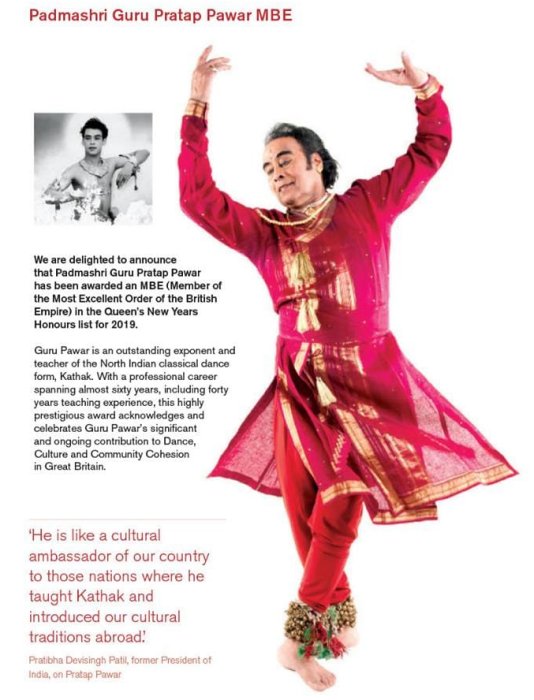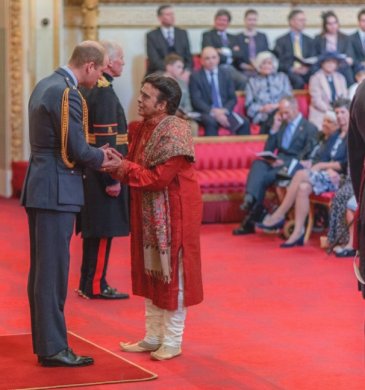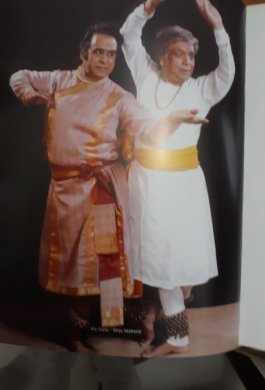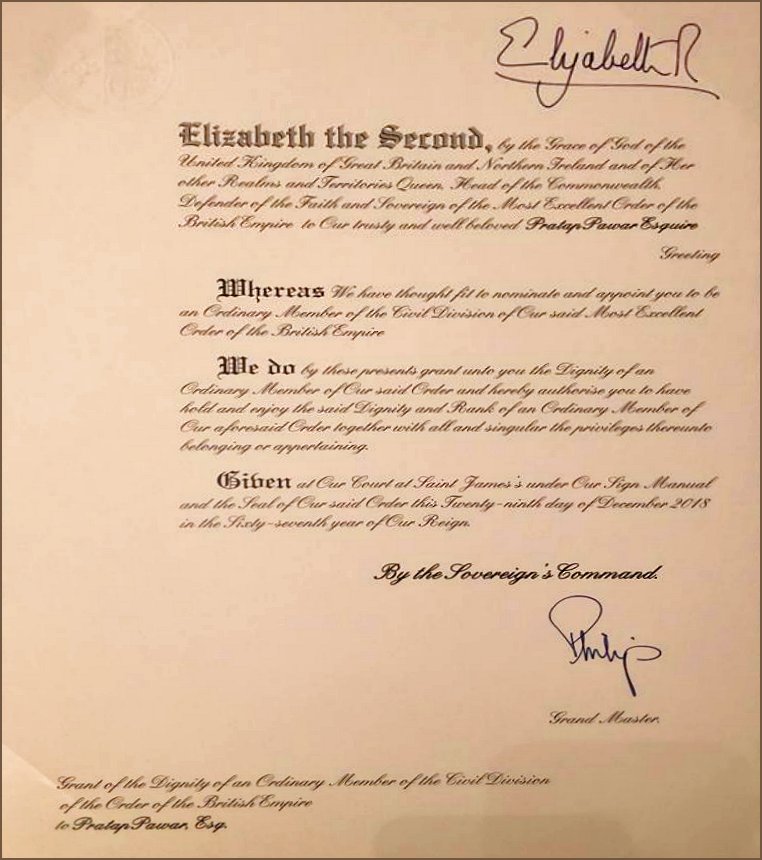Narthaki

News

Info

Featured

 |
  |
In praise of MBE awardee Kathak exponent Pratap Pawar - Dr.Sunil Kothari e-mail: sunilkothari1933@gmail.com May 7, 2019  A few days ago I received a call from my friend Pratap Pawar in London informing me that he was awarded MBE, 'Member of the Most Excellent Order of the British Empire' in the Queen's New Year's honour list for 2019. I wished him my heartiest congratulations. From among the Indian dance community in London, he is one of the few artistes to receive this award.  Pratap Pawar receives award from Prince William He spoke of major events in his career and suggested that I refer to his autobiography 'My Journey in Dance: Guru Pratap Pawar' by Ashish Khokar (published by Clarion Books /Hind Pocket Books in 2010) for major important events as all copyrights are his. It was quite interesting to read his autobiography told in first person. I have known him from 1959. Since I had started writing on dance from around 1957 in Gujarati and later on in English, many events which are mentioned in the book I knew of and it was an interesting 'down memory lane' for me. Also I realized how Pratap had to undergo several difficulties as a male dancer to study dance when there were few courageous persons to take to dancing from a middle class family way back in early fifties. I remember in 1959 when I was visiting New Delhi, I had met him when he was studying Kathak under Birju Maharaj. My guru and mentor Prof Mohan Khokar had told me to learn photography and take photos of dancers whom I interviewed. Birju Maharaj was at that time teaching Shovana Narayan also. I took photos of both Pratap Pawar and Shovana Narayan. My interest in dance developed watching performances in Mumbai. It was a cultural capital for dance in fifties. Brijnarain was the Director of Sur Singar Samsad and held Swami Haridas Sammelan every year. All the leading lights of Kathak performed at Swami Haridas Sammelan. I remember having seen Maya Rao and Shambhu Maharaj performing together. Later on I used to regularly see Birju Maharaj whenever he performed in Mumbai. Sitara Devi, Damayanti Joshi, Roshan Kumari, Gopi Krishna were the stars who drew huge crowds. Devi Lal and Durga Lal were also part of the Kathak scene.  Pratap Pawar and Birju Maharaj Pratap Pawar belonged to that artistic community. Hailing from Dewas, Madhya Pradesh, from a Maharashtrian family, against his father's wish he studied dance. In the beginning he was drawn to Bharatanatyam and studied it from a local teacher against all odds. But when he visited Delhi, his cousin Kamal Kiritikar asked him to take part in Ramlila. He was not keen to learn Kathak but when he returned to Indore, Kamal sent him an application form to take part in Ramlila from Bharatiya Kala Kendra. He applied and was auditioned and selected. He played the role of Indrajit. He came in close contact with Birju Maharaj. They were practically of the same age. Later on, he became the first student of Birju Maharaj and tied a thread on his wrist, touched feet of Maharaj who put tilak on his forehead. The entire ceremony is called 'ganda bandh,' a ceremony where guru accepts the student as his disciple. Thus Pratap became the first 'gandha bandh' disciple of Birju Maharaj. Kumudini Lakhia was also at that time in Delhi studying under Shambhu Maharaj. She gave an application form to Pratap to apply for a scholarship to learn Kathak. He applied and was lucky to receive the scholarship. The rest is history. He made strides learning Kathak and performed as a solo dancer. At that time his contemporaries were celebrated sarod player Amjad Ali Khan; other male dancers were Tirath Ajmani, Pradeep Shankar, Devi Lal and Durgalal. Among female dancers, Rani Karnaa was a prominent Kathak dancer, a disciple of Narayan Prasad of Jaipur gharana. Others who started studying Kathak were Rashmi Vajpeyi, Uma Sharma and Bharati Gupta. Sumitra Charatram was at the helm of Bharatiya Kala Kendra. Lacchu Maharaj had choreographed 'Malti Madhav' dance drama in which Krishna Kumar played the lead role of Madhav and Kumudini that of Malati. That was the time when Kathak scene was most vibrant. Shambhu Maharaj, Sunder Prasad were engaged to teach Kathak. Later on when Kathak Kendra was established, young Birju Maharaj was appointed as a guru to teach Kathak at Kathak Kendra. When he got established and started giving solo performances all over India, thanks to Gopi Krishna, who had made a big name in films after his appearance in V.Shantaram's film 'Jhanak Jhanak Payal Baje,' he invited Pratap to perform in Mumbai. Being a close friend, he also asked him to appear in a film for a small role as a dancer. However, Pratap did not like to perform wearing a suit and dance. He had decided to make a name in the field of classical dance. He declined to appear in films. He had agreed earlier and had appeared in a film 'Dastan' in 1971. He did appear and choreograph a dance number in a film 'Anmol Bandhan' in 1974 and had a lead role in an English film 'Sound of Sugarcane' in 1975. One more Indo-French film titled 'One Dollar Curry' for which Zakir Hussain had composed music in 2000. That was the entire brush he had with Bollywood. Pratap recalls that when Indira Gandhi visited Guyana, she saw that a large number of Indian community had migrated and settled there. She wished to establish a Centre for Indian Arts. On her return she told authorities of Indian Council for Cultural Relations (ICCR) to start a center and make arrangements to teach North Indian dance form and classical music. As luck would have it, Pratap was selected as the Kathak teacher for the new centre at Guyana. He was an excellent teacher besides being an ace performer and within three years of his contract, which was extended for one more year, he taught local dancers and gave several performances. His fame reached Trinidad and Tobago. When he performed at Trinidad on an invitation, the Indian High Commissioner liked his performance and invited him to visit regularly and train artists. Pratap taught there winning popularity and for four years he taught at a centre called 'Kala Kendra' even when there was no centre of ICCR in Trinidad. It so happened that during last year of his stay there, he developed a cyst and for treatment he was sent to London where after a fortnight it was diagnosed that it was not cancer. Doing his medical examination in London, he met director Mathoor Krishnamurty of Bharatiya Vidya Bhavan, which was getting established. They were in need of an experienced teacher who could teach classical dance form like Kathak. Instead of returning to India after his contract was over with ICCR, Pratap chose to settle down in London. He was appointed as a teacher at Bharatiya Vidya Bhavan. Soon his wife Vishnupriya, known as Priya and their daughter Asavari and son Prashant joined him. Priya knew Odissi also. They used to perform duets together, besides Pratap's solo performances. In no time, Pratap earned reputation as a good teacher and also a performer. In a way he was a pioneer teaching Kathak in London. Even when Birju Maharaj, Kumudini Lakhia, Shovana Narayan, Uma Sharma, and others were visiting London, they were mainly performing Kathak and not teaching. Pratap was not only performing solo, but also teaching Kathak and established Kathak as a major classical dance form in London. Bharatiya Vidya Bhavan helped him a lot. Soon invitations came from Scotland where he conducted workshops. Later on he sent another Kathak dancer Sudarshan Dheer to teach there establishing an institution to teach Kathak.  Pratap Pawar and Priya Pratap and Priya established Triveni Dance Company and a School of Kathak at Harrow. After Pratap left Bharatiya Vidya Bhavan, they engaged another brilliant Kathak dancer Nahid Siddiqui to teach Kathak as she had studied at Kathak Kendra in Delhi. Meanwhile, Pratap's disciples were receiving attention for their good training and performances. During one of his performances, one officer from British Arts Council liked Pratap's performance so much that he asked Pratap to apply for a grant, which he explored to study Flamenco and with a Flamenco dancer Sandra Lopez he gave a performance in 1982. Later on, with its unprecedented success he choreographed a longer piece and titled it as 'Dream of Mughal Prince' with Flamenco dancer Juani. Pratap visited India and brought Kathak Flamenco work to Kolkata. I was at that time Professor and Head, Dept of Dance at Rabindra Bharati University. I invited him and his partner to perform at the University. It was a big success. Pratap had arranged for a larger production and received assistance from the Embassy of Spain to present Kathak Flamenco in Delhi. Also Vasanth Sathe, who was President of ICCR, helped him travel with Kathak Flamenco within India to many other cities. Jose, Juani, Pratap and Priya won critical acclaim for their innovative idea for presenting Kathak and Flamenco. Pratap had also experimented using two forms together, Odissi and Kathak - Priya performing Odissi and Pratap performing Kathak. That jugalbandhi was also much appreciated. Among Pratap's disciples is well known dancer Akram Khan. He was a young dancer born in London of Bangadeshi Muslim origin. He has later on studied contemporary dance but kept classical Kathak separate. Today, Akram Khan is a big name internationally as a performer and a choreographer and acknowledges his success to his guru Pratap Pawar. Having taken part in Ramlila and dance-dramas of Kathak Kendra, Pratap had experience of choreographing dance-dramas which became very popular. In Trinidad, he choreographed 'Ramayana' and 'Padmini.' Settling in London, he choreographed several short dance-dramas. He planned a spectacular evening of Kathak, 'Drop in the ocean' in December 2008 which was a runaway success. He also choreographed 'Ritusingar', 'Padmini' and several other works. But essentially he loved performing solo and shone forth in solo performances. He has several firsts to his credits: He is first 'ganda bandh' disciple of Birju Maharaj, first dancer to have major roles in productions of Kathak Kendra from 1965-1972. He was the first dancer chosen to teach and propagate Kathak abroad by ICCR in 1972, first to perform in South America, first to start full time Kathak training at Bharatiya Vidya Bhavan commencing from 1980, first to develop concept of 'East meets West' in field of dance in 1982 in the UK, Caribbean and USA, first to choreograph dance-dramas in UK and the West Indies using local talents. And now he is honored with an MBE.  Citation His daughter Asavari studied Kathak from him and is regularly performing Kathak with her own troupe and runs an academy in Delhi. Son Prashant with his MBA degree works independently dealing with financial management. I met Pratap three years ago in 2016 when I visited London for Navadisha conference held at Birmingham. He was performing one evening briefly as a part of the Navadisha celebrations. He was in his usual form and won appreciation from his large fan circle. He is much respected as a Guru and has a large following. Among his global disciples, he mentions Akram Khan, Alpana, Balbir, Caroline, Deepa, Deveika, Janine, Kailash, Nisha, Riaz, Sandy, Shobha and Valerie as his gifted disciples. He has a legion of students mainly abroad. Pratap visits India/Delhi regularly. He considers it a great blessing that Birju Maharaj is very fond of him and he says that whatever he is today, he owes it to Birju Maharaj. He feels humbled for the recognition and fame including Padma Shri he has received and for the latest MBE award. He wishes his disciples will carry on the legacy he has received from his guru doing Birju Maharaj and him proud. Pratap says that he has been away from Birju Maharj for more than 60 years now but not a day passes without remembering him. He visits India whenever he can and keeps in touch with his old associates and friends. But now his karmabhumi he says is London. He is extremely happy that the Biritsh Government has recognized his contribution and honoured him.  Dr. Sunil Kothari is a dance historian, scholar, author and critic, Padma Shri awardee and fellow, Sangeet Natak Akademi. Dance Critics' Association, New York, has honoured him with Lifetime Achievement award. Post your comments Please provide your name and email id along with your comment. All appropriate comments posted with name and email id in the blog will also be featured in the site. |